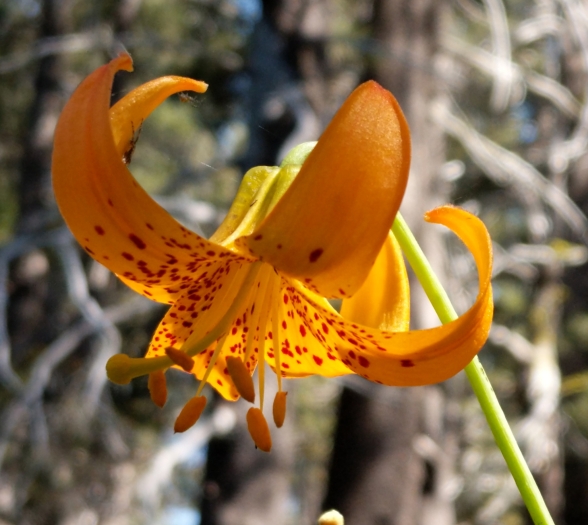Kelley’s Lily
(Lilium kelleyanum)
Kelley’s Lily (Lilium kelleyanum)
/
/

Rick Mandel
CC BY 4.0
Image By:
Rick Mandel
Recorded By:
Copyright:
CC BY 4.0
Copyright Notice:
Photo by: Rick Mandel | License Type: CC BY 4.0 | License URL: http://creativecommons.org/licenses/by/4.0/ | Rights Holder: Rick Mandel | Publisher: iNaturalist | Date Created: 2018-07-15T10:52:54-07:00 |












Estimated Native Range
Summary
Lilium kelleyanum, commonly known as Kelley’s lily, is a perennial herb that is native to moist meadows, streambanks, and subalpine zones in the Sierra Nevada, Coast Ranges, and southern Cascades of northern California. It can grow over two meters tall from a scaly, elongated bulb and is characterized by its striking height and the arrangement of its leaves in whorls along the stem. Kelley’s lily bears up to 25 large, nodding bell-shaped flowers with yellow to orange tepals, typically blooming from June to August. The flowers are quite showy, with six prominent stamens featuring red anthers and a long pistil, and they are known to attract swallowtail butterflies for pollination.
Kelley’s lily is appreciated for its ornamental value, particularly the vibrant color and large size of its flowers. It is used in wildflower gardens and naturalized areas where its height can add vertical interest. In cultivation, it requires conditions that mimic its native habitat, including moist, well-drained soil and full to partial sunlight. While not commonly found in the nursery trade, it can be propagated from seed or bulb scales. Gardeners should be aware that it may require protection from herbivores, as its lush foliage can be attractive to deer and other wildlife.CC BY-SA 4.0
Kelley’s lily is appreciated for its ornamental value, particularly the vibrant color and large size of its flowers. It is used in wildflower gardens and naturalized areas where its height can add vertical interest. In cultivation, it requires conditions that mimic its native habitat, including moist, well-drained soil and full to partial sunlight. While not commonly found in the nursery trade, it can be propagated from seed or bulb scales. Gardeners should be aware that it may require protection from herbivores, as its lush foliage can be attractive to deer and other wildlife.CC BY-SA 4.0
Plant Description
- Plant Type: Herb, Bulb
- Height: 1.5-3 feet
- Width: 1-2 feet
- Growth Rate: Slow, Moderate
- Flower Color: Orange, Red, Yellow
- Flowering Season: Summer
- Leaf Retention: Deciduous
Growth Requirements
- Sun: Full Sun
- Water: Medium
- Drainage: Medium
Common Uses
Bee Garden, Bird Garden, Butterfly Garden, Low Maintenance, Water Garden
Natural Habitat
Native to moist meadows, streambanks, and subalpine zones in the Sierra Nevada, Coast Ranges, and southern Cascades of northern California
Other Names
Common Names: Sierra Tiger Lily, Lemon Lily
Scientific Names: , Lilium kelleyanum, Lilium fresnense, Lilium inyoense, Lilium nevadense var. fresnense, Lilium nevadense var. monense, Lilium pardalinum var. parviflorum,
GBIF Accepted Name: